
- Oceania is a region in the Pacific Ocean. It consists of 4 subregions, Australia and New Zealand, Polynesia, Melanesia, and Micronesia.
- Approximately 43 million people live in Oceania.
- Oceania contains 14 independent countries and 8 dependencies.
- Most of the countries of Oceania consist of many tiny islands.
- Nearly three quarters of Oceania’s people live in the countries of Australia and New Zealand.
Contents:
- Australia And New Zealand
- Polynesia
- Melanesia
- Micronesia
Australia And New Zealand
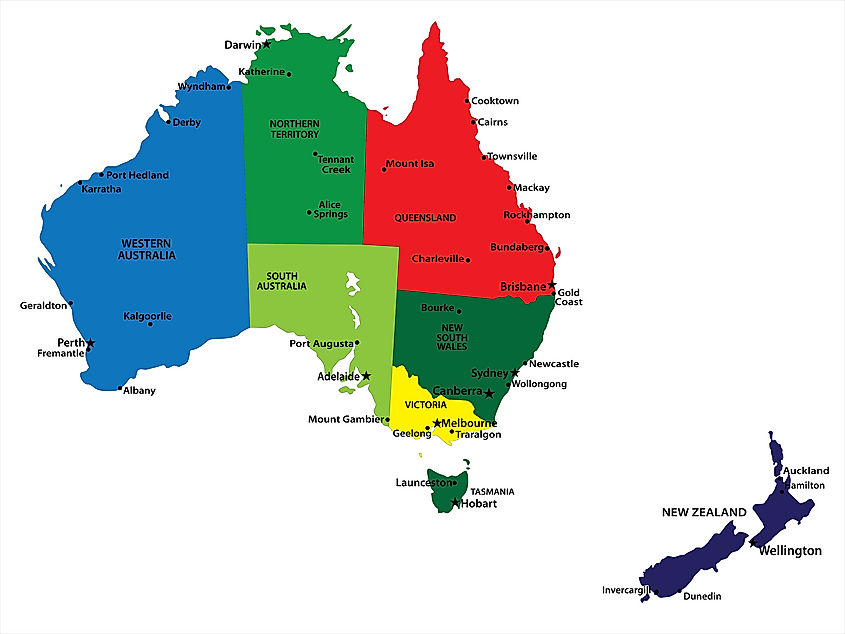
Australia and New Zealand collectively contain more than 30 million people, which is nearly three quarters of the entire population of Oceania. Australia itself has a population of approximately 25.7 million, while New Zealand’s population is close to 4.85 million. Most of the people in both countries are of European descent, but there are sizeable non-European populations as well. Australia has an indigenous population known as Aborigines. Some believe that this population is the oldest human population outside of Africa, theorizing that they arrived in Australia by boat about 70,000 years ago. There are 250 distinct language groups among the Australian Aborigines. In contrast, New Zealand’s indigenous population is composed of one group, the Maori, who are believed to have migrated to New Zealand about 1,200 years ago.
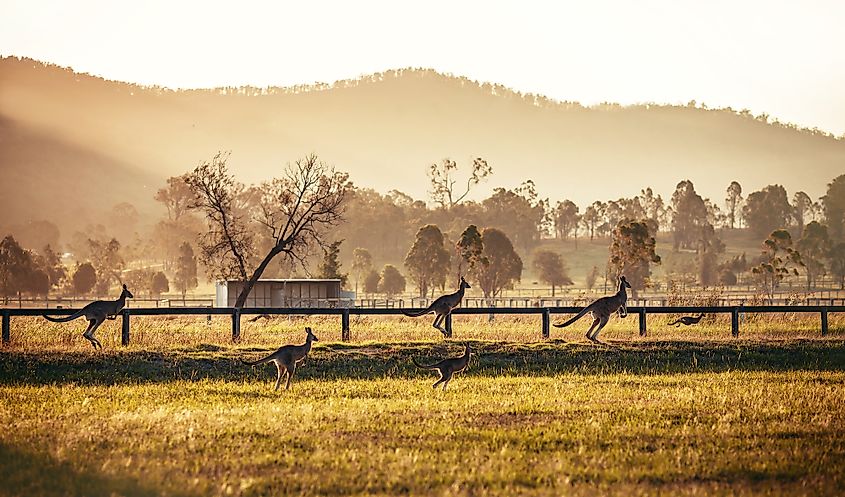
Much of Australia is barren and inhospitable. In fact, most of Australia is low desert plateau. Australia does, however, have more fertile land in areas closer to the country’s coast, especially in the southeast, where much of the Australian population lives. The ecosystem of Australia is also very diverse and includes many plants and animals not seen anywhere else. Australian culture is widely popularized in movies and television. When people around the world think of Australia, they often think of Foster’s beer, boomerangs, and kangaroos, though there is certainly more to the country’s culture.
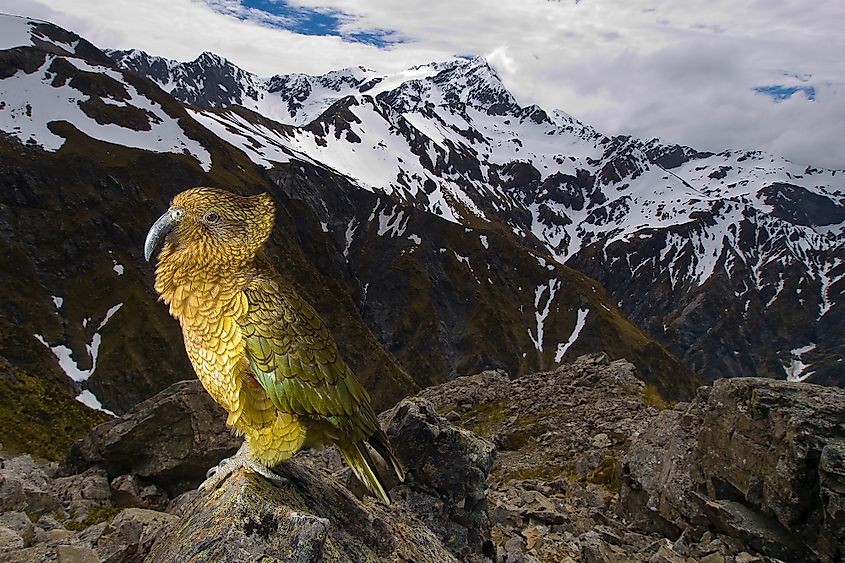
New Zealand has a wide variety of geographic regions. You can find just about any kind of geographical feature in the country, including glaciers, mountains, plains, fjords, subtropical forests, and volcanic plateaus. The country’s two large islands are known simply as the North Island and South Island. As previously mentioned, New Zealand consists mostly of people of European descent and the indigenous Maori. They are equally proud of both the European and indigenous aspects of their culture. All New Zealanders are affectionately called kiwis, after the bird species that is indigenous only to New Zealand.
Both Australia and New Zealand were both British colonies, and are now constitutional monarchies and parliamentary democracies. Australia is a federation of six states and ten territories. Both countries also have developed economies, which is unique in Oceania, as the rest of the region’s countries host developing economies. In fact, the Australian economy, valued at over a trillion US dollars, is bigger than all the other economies in Oceania combined.
Polynesia
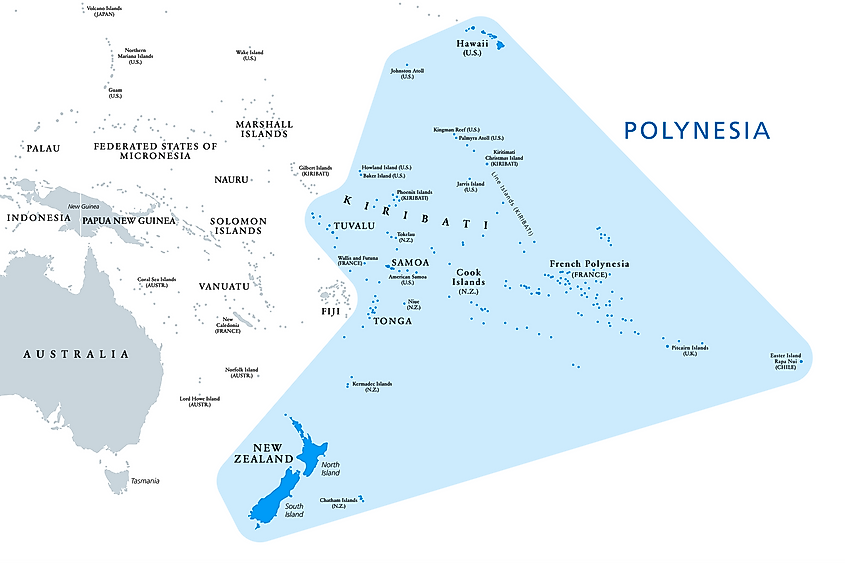
Polynesia is the easternmost subregion of Oceania. The name Polynesia is a Greek word literally meaning “many islands”. Indeed, the subregion of Oceania contains more than 10,000 islands. The islands of Polynesia belong to 3 independent countries and 6 dependencies.
About 687 thousand people live in Polynesia. The first humans settled Polynesia between 1300 and 900 BCE. The first European contact with Polynesia occurred in the late 16th century. By the early 1900s, the entire subregion was colonized by European powers. Samoa, Tonga, and Tuvalu became independent states in 1962, 1970, and 1978 respectively. Samoa and Tuvalu are democratic republics, while Tonga is a constitutional monarchy. The dependencies of Polynesia are French Polynesia, American Samoa, the Cook Islands, the Wallis and Futuna Islands, Niue, and Tokelau.
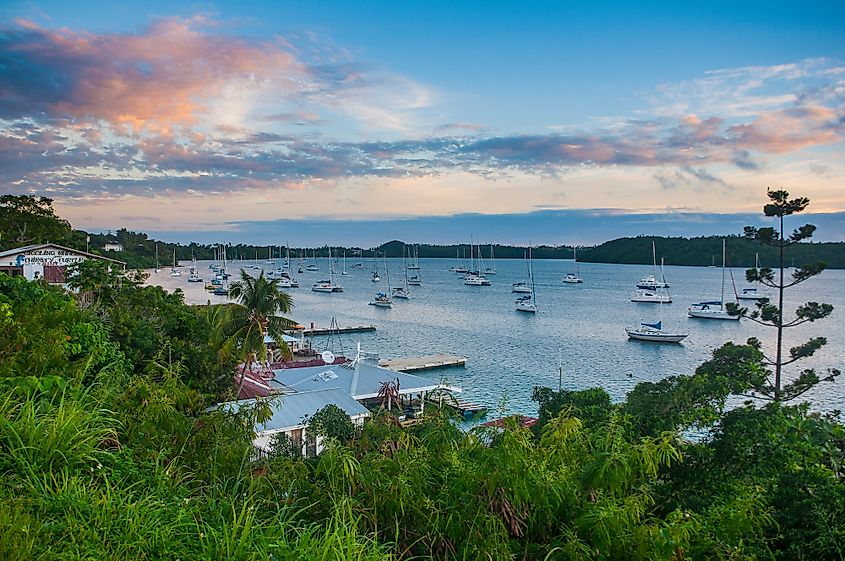
French Polynesia and the Wallis and Futuna Islands are controlled by France, American Samoa by the U.S., and the Cook Islands, Tokelau, and Niue by New Zealand. French Polynesia is the most populous territory in Polynesia, with a population of approximately 281 thousand, while Tokelau is the least populous with less than 1,400 people.
Many Polynesians still depend on subsistence farming. There are, however, some agricultural exports from the subregion. Coconut, for example, is often exported from Polynesia. Tonga exports vanilla. Fishing is also a common activity among Polynesians. The fastest-growing economic sector in the subregion, however, is probably tourism.
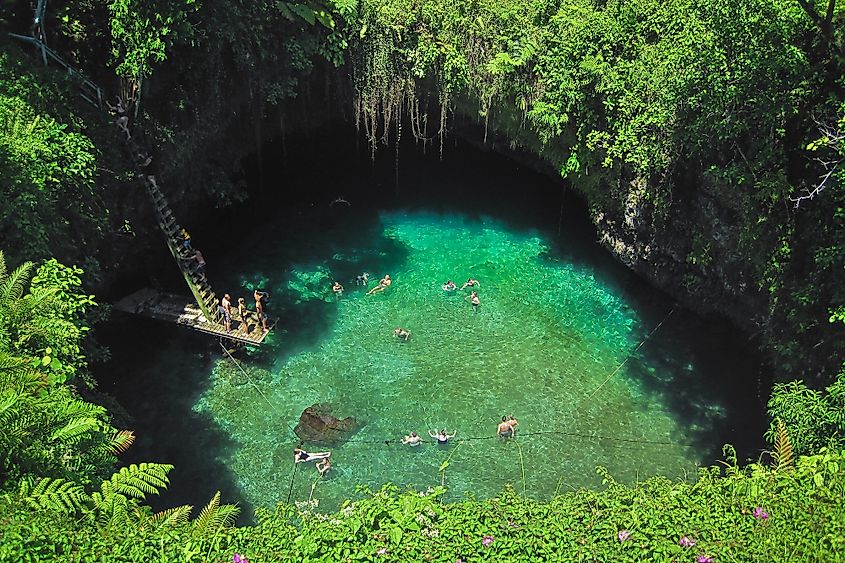
The people of Polynesia speak multiple languages. In fact, nearly all the countries and territories of the subregion have their own indigenous languages. The countries of Samoa, Tonga, and Tuvalu each have languages of their own, as do the New Zealand dependencies of Tokelau and Niue. The French dependency of Wallis and Futuna has two indigenous languages, Wallisian and Futunian. French Polynesia has several languages indigenous to each island group. Many Polynesians also speak the languages of their territories’ current or former European colonial power.
Polynesian culture has both indigenous and foreign influences. In Tahiti, for example, people sing himene, which is Tahitian for hymns. These are often Christian hymns that blend both European and Tahitian sounds. Do you like to surf? If you do, you can thank the Polynesians, as the modern sport of surfing was created when Europeans observed the native Polynesians doing it.
Melanesia
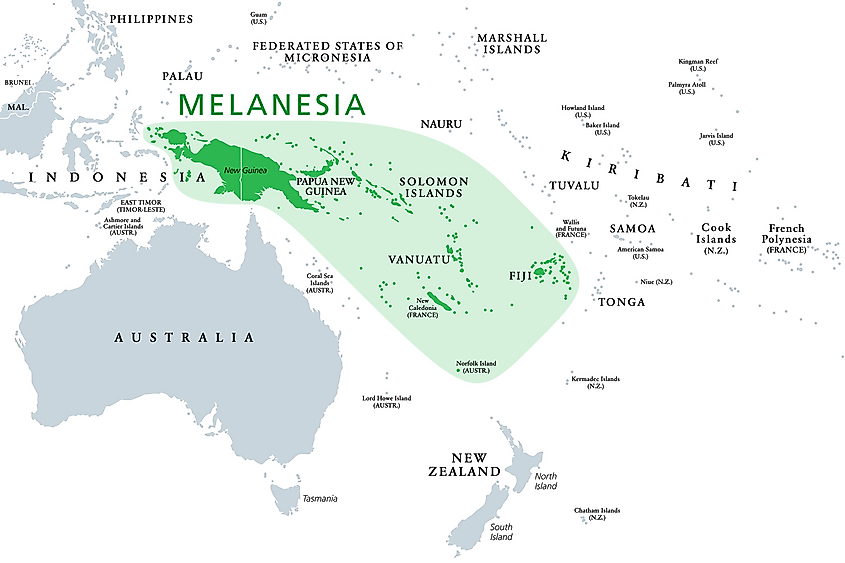
Melanesia consists of 2,000 islands stretching east to west from the Arafura Sea in Indonesian waters to the eastern side of the western Pacific Ocean, and from north to south from the island of New Guinea to the waters south of New Caledonia. About 11.2 million people live in Melanesia. Most of them, almost 9 million, live in the country of Papua New Guinea, which is also the largest country in the subregion. The rest live in the three other countries of Melanesia, Fiji, the Solomon Islands, and Vanuatu, as well as the French dependency of New Caledonia.
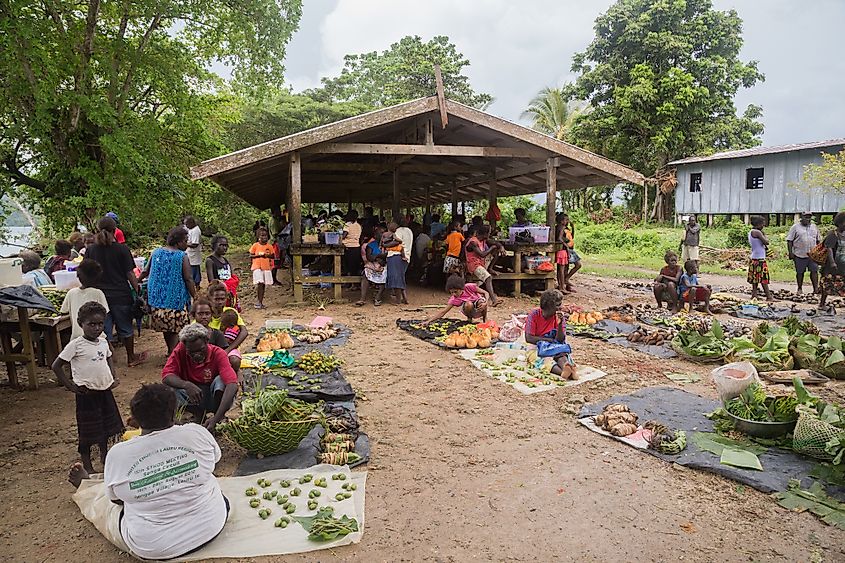
The indigenous people of Melanesia are mostly dark-skinned. In fact, the name Melanesia is derived from Greek and means “black islands”. Human settlement in Melanesia dates back to 70,000 years ago. European contact with Melanesia took place in the 17th century, with colonization beginning in the 18th century. By the late 1800s, European powers controlled all of Melanesia. The independent countries of Fiji, Papua New Guinea, the Solomon Islands, and Vanuatu gained their independence in 1970, 1975, 1978, and 1980 respectively. Papua New Guinea and the Solomon Islands are constitutional monarchies, with the British monarch as their ceremonial head of state, while Fiji and Vanuatu are republics.
Hundreds of languages are spoken in Melanesia. In fact, there are 700 languages spoken in Papua New Guinea alone. The Solomon Islands has 120 indigenous languages, and Vanuatu more than 100. The indigenous language of Fiji is known simply as Fijian. The Kanak people, who are the dominant ethnic group in New Caledonia, have 28 different languages and 11 dialects. Many people of Melanesia also speak the languages of the current or former European colonial powers.
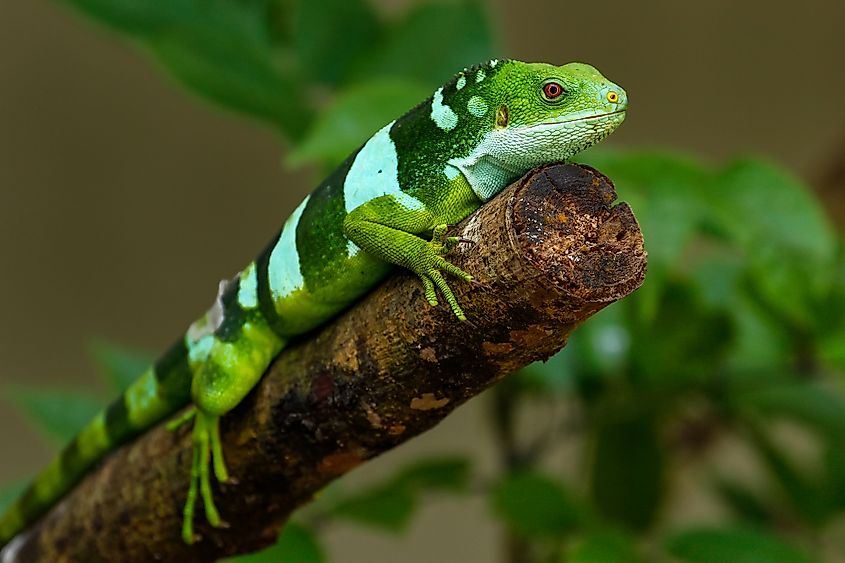
Melanesia is rich in natural resources. New Caledonia, for example, has about 10% of the world’s entire nickel reserve. The rainforests of the Solomon Islands provide forestry products. Tourism is also an expanding sector in Melanesia, as is mining and logging, much to the chagrin of some local communities, who wish to preserve their environment and traditional way of life.
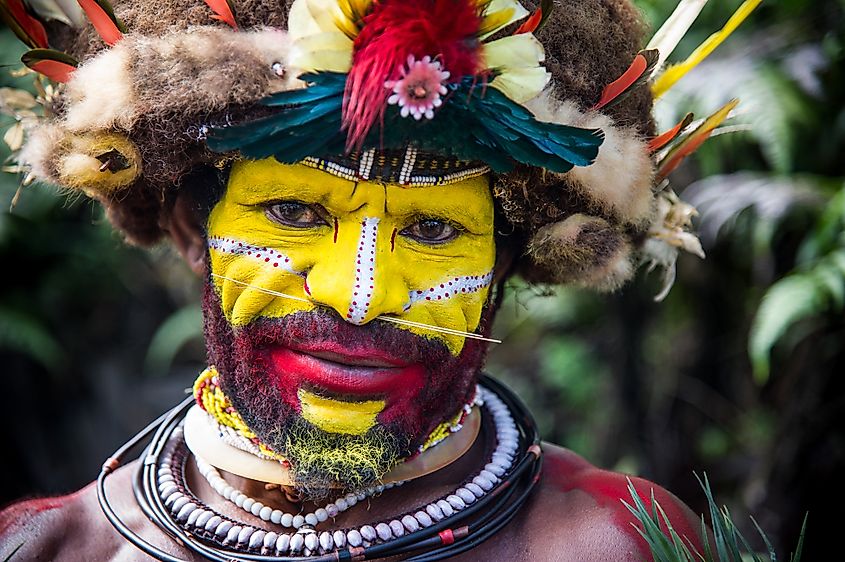
Indeed, many Melanesians still live traditional lifestyles. Some, for example, still wear traditional clothing. Melanesians still adorn themselves with tattoos, paint their faces and bodies, and dawn unique headdresses. Nevertheless, Western cultural influences, such as the introduction of Christianity have altered the cultures of indigenous Melanesians.
Micronesia
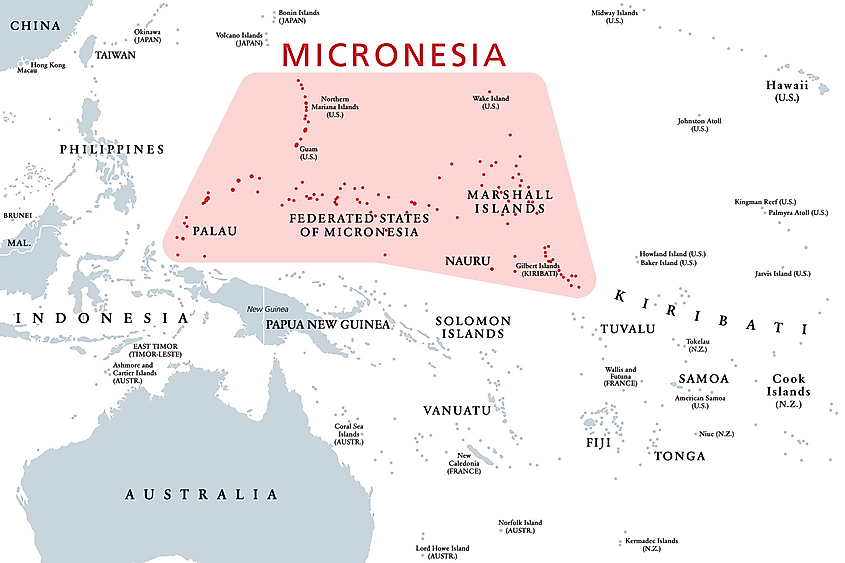
Micronesia, which is Greek for “small islands”, is situated in the western Pacific Ocean, east of the Philippines, west of Polynesia, north of Melanesia, and south of Japan. About 983 thousand people live in Micronesia. There are 5 independent countries in Micronesia, the Federated States of Micronesia, Kiribati, the Marshall Islands, Palau, and Nauru. There are also 2 dependencies in Micronesia, Guam and the Northern Mariana Islands, both controlled by the U.S. Over half of the population of Micronesia lives in the country of the same name. The Federated States of Micronesia has a population of approximately 553 thousand. The tiny island country of Nauru is the least populous, and has just under 11,000 people. The 5 independent countries of Micronesia are all democratic republics.
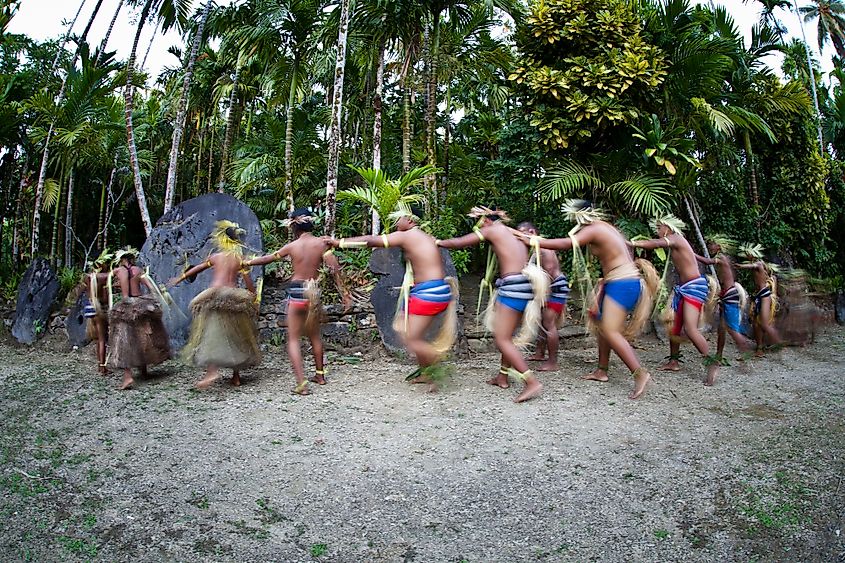
The first humans in Micronesia arrived about 3,500 years ago. The first Europeans came to the subregion in the 16th century. By the 19th century, Europeans had colonized the entire subregion. Decolonization began in the late 1960s. By the mid-1980s, all the current countries of Micronesia had achieved independence, while Guam and the Northern Mariana Islands remain under U.S. control.
Many Micronesians still engage in subsistence agriculture. Phosphate mining was conducted in Nauru until the late 20th century. Some commercial fishing takes place in Micronesian waters. The U.S. military also provides employment for people living in Guam and the Northern Mariana Islands. Space-launching facilities are located in Kiribati. Tourism is also a growing economic sector in the subregion. Foreign aid, particularly from the U.S., is still a major source of revenue for the countries of Micronesia.
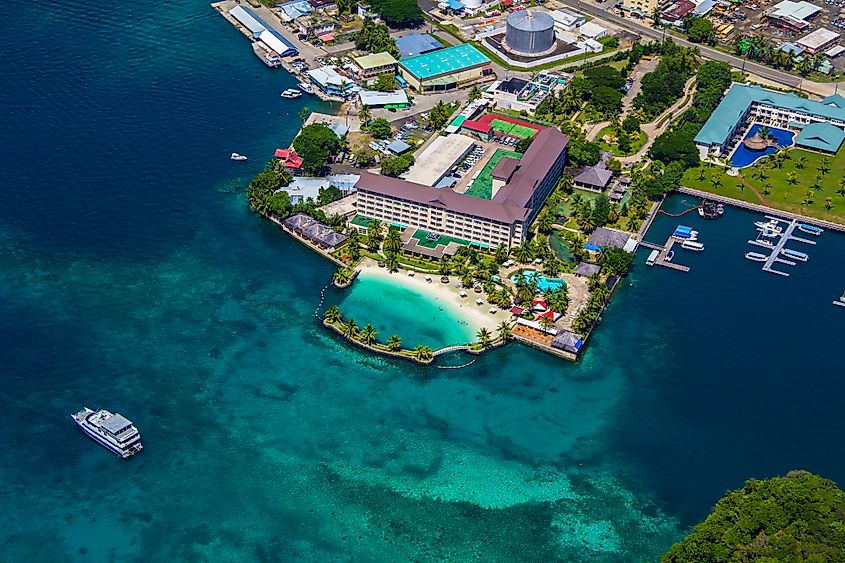
Most of the people of Micronesia are of Micronesian descent, though some have mixed Micronesian and Melanesian heritage. There are many languages spoken in Micronesia. The countries of Palau, Nauru, and Kiribati each have their own indigenous national languages. Several languages are spoken in the Federated States of Micronesia. Chamorro is spoken by the people of the same name in Guam and the Northern Mariana Islands. Indigenous religions are still practiced to an extent in Micronesia, though most people of the subregion are now Christian. Some Micronesians still wear traditional dress, such as loincloths. Traditional dances and music are also still popular, though such entertainment is often mixed with Western customs.


 Users Today : 632
Users Today : 632 Total views : 464384
Total views : 464384